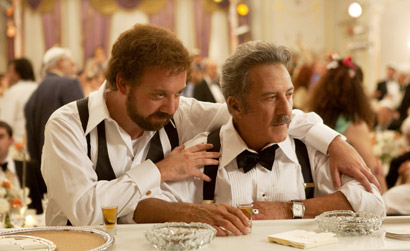Ed Tuccio is nestled into a corner booth of his restaurant, Tweed’s in Riverhead, sinking his teeth into one of his restaurant’s signature bison burger patties.
“Eating should be an adventure,” says Tuccio, in between bites. “It’s not just for survival.”
Tweed’s Restaurant and Buffalo Bar sounds like something out of the Wild West, where cowboys and outlaws would gather and get rowdy after a duel, rather than an upscale eatery. But the restaurant is as Long Island as it gets.
Tucked unassumingly on the corner of the town’s East Main Street, it’s easy to dismiss. But a peek inside grants a rare glimpse into the town’s history. Tweed’s walls are adorned with relics of Riverhead’s past, framed snapshots of Long Island life frozen in time—sepia-toned photographs of the old East Main Street, currency printed from local banks during the Great Depression, a Riverhead resident’s Civil War discharge papers signed by Lincoln himself. But your eyes immediately dart to the behemoth mounted proudly above the bar: a majestic buffalo head, brought down by Long Island’s own Teddy Roosevelt. Once you make eye contact with the massive stuffed beast, you know you’re in for an experience like no other on LI.
This love affair with bison, which Dee Muma, Tuccio’s herding partner and wife of more than 30 years, refers to as “Ed’s midlife crisis,” has blossomed not only into a thriving business for the couple, but also a lifestyle. They share their Riverhead home with a herd of bison—the very same bison they serve in Tweed’s.
Their herd, which started almost 30 years ago with two pregnant females, is now 300 strong—the largest bison herd in the Northeast. For Tuccio and Muma, it is very much a labor of love. “Our lives are touched every day by our bison herd,” says Tuccio. “We oversee their life. They depend on us for their life.” In a lot of ways, Tuccio and Muma depend on them too—as the lifeblood of their business.
Bison meat, which Tweeds’ Executive Chef Jeff Trujillo describes as having the leanness of venison and the flavor of beef, is so healthy, it makes you wonder why it didn’t go mainstream years ago. It contains less than half the calories of skinless chicken, and a fraction of the fat content of the bison’s bovine cousin. It’s so lean, in fact, that it is challenging to prepare. “The fat is what forgives a lot of sins,” says Trujillo. “So [bison] is unforgiving.” For this reason, Tweed’s, like most bison-serving establishments, strongly encourages that dishes be served rare to medium-rare.
Trujillo admits that despite the restaurant’s packed tables and rave reviews, the concept of consuming bison has proved hard to swallow for much of the public, which he describes as “still in beef mode.” “It took ’em a while to get on board,” says Trujillo. But the crowds keep coming, and each week, Tweed’s converts patrons into believers. Another customer concern, which Muma says is the biggest bison misconception, is that they are an endangered species. “[Customers] look at us like we are suggesting eating the last condor,” she says.
Even Trujillo says that when he took the job at Tweed’s, he had never worked with bison before. “In the beginning, I was reading about it at night and cooking it during the day. I went with my gut feeling a lot of the time,” he says. “Now, I pretty much know the animal from snout to tail.”
The idea shared by the general public and even those in the culinary world that buffalo is an endangered species isn’t wrong, it’s just misplaced—by about 300 years. Throughout the 19th century, the American buffalo population was nearly wiped out by European settlers, in an attempt to starve out Native Americans. Within 60 years, the settlers killed nearly 60 million buffalo. The population dwindled into the hundreds. It has since bounced back, with about 500,000 roaming North America today. In Riverhead, rather than being hunted by vagabonds and nomads, the bison are carefully watched over.
Every morning, Muma rises around dawn to feed the herd. And this herd isn’t just munching on grass. These bison have a healthier diet than most people—all natural and all locally grown produce. In addition to grass, the bison are regularly fed the food that farmers usually discard—potato pickouts, apple pressings from cider mills, leftover post-Halloween pumpkins. Blue Point Brewery regularly donates their leftover hops for the bison to snack on. “In a farming community, you rely on your neighbors,” says Muma.
This philosophy translates onto Tweed’s menu, which abounds with fresh local produce, meat and fish. It’s rare that one can eat a dish in a restaurant and then drive down the road to see where all the ingredients came from.

Ed Tuccio’s Riverhead farm began with two bison and now has hundreds. (Joel Cairo/Long Island Press)
According to Trujillo, a Hamptons native, it’s one of the best aspects of working in a restaurant on the North Fork. Rather than wait for his ingredients to be shipped to him, he goes out and finds them. “I go up the street. Everybody knows everybody here. I know that the stuff I’m getting off of a truck is harvested that morning,” he says. “It doesn’t get any easier, and for a chef, it doesn’t get any better.”
This locally owned, locally stocked establishment is just what Muma and Tuccio have aimed for, and an idea that they hope is replicated by other local businesses. By building a community that helps one another, Muma aims to reinvent suburban living in Riverhead. She calls it “urban, with a face.” By forming a self-sustaining community, they not only create a healthier lifestyle for themselves and the environment, but breathe life into a struggling town.
“This is the County Seat,” Muma says matter-of-factly. “It was the most advanced town on Long Island,” noting landmarks like the Vail-Leavitt Music Hall, an opera house that was built in the 1800s and still stands today. “It’s coming back.”
Like the music hall, Tweed’s, which resides inside the historic J.J. Sullivan Hotel building, celebrates the history of Riverhead in a modern context. Tuccio and Muma’s bison farm and local mentality both bind them to the past and usher them into what looks like a bright future.
For his part, Tuccio would be happy just to be remembered as “The Buffalo Man.”
“If I expose a fraction of the people of Long Island to bison, that will be great,” he says. “I’m happy to have any association with bison.”







